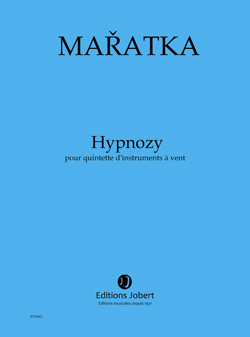HYPNOZY
wind quintet
(2006)

Movements:
- Session I
- Session II
- Session III
- Session IV
- Session V
Duration: 25’
Commissioned by the André Boucourechliev Foundation.
Premiere: Miro Ensemble: Clara Andrada (flute), José Manuel González (oboe), Isaac Rodriguez (clarinet), David F. Alonso (horn), Guillermo Salcedo (bassoon), 2006, Festival Pablo Casals de Prades
Publisher: The Henry Lemoine Editions display more information on this work on
http://www.henry-lemoine.com/fr/catalogue/compositeur/maratka-krystof
For more information, contact:
Henry Lemoine Editions – Paris
Mrs Laurence Fauvet - Rental and purchase of score
orchestre@editions-lemoine.fr / +33 (0) 1 56 68 86 75
Jobert Editions
Henry Lemoine Editions – Paris
Mr. Benoît Walther - Promotion and distribution service
bwalther@editions-lemoine.fr / +33 (0) 1 56 68 86 74
Jobert Editions
Recording:
Extract from the score:
Notes on the work:
Hypnózy is a vast five-movement wind quintet, a ritual of five hypnotic sessions, each promoting one of the five instruments of the quintet. The work strikes above all with its unusual sounds. One would think to recognise extra-European timbres; the score itself mentions at times a “shakuhachi flute effect” (Sessions I and II) for brash flute attacks, “resonating with some higher harmonics”, or an “evocation of the Australian didgeridoo” in the bassoon, with its modulation of harmonics on a fundamental in extreme low notes (Session II). However, the composer did not seek so much to imitate existing timbres as to reveal the sound potential of each instrument of the western wind quintet, which emerges transfigured from the process. The score also uses various types of harmonic sounds: simple, multiphonic and split tones. The combination of the timbres is moreover coloured by microtonal inflections, a sound being at times uttered by two instruments at the same time at its tempered height and slightly lower or higher.
1st movement
Each Session is preceded with a short poetic epigraph chosen by the composer to enlighten its content. For the first, it is: “The purity and serenity of the sound of the flute. The other instruments perform brief and ceremonial sequences.” The “privileged” instrument is thus the flute, its sound being coloured by the clarinet, the oboe, the horn. The Session is clearly polarized around a single sound, this E on which it opens. As a unifying element, the closing gesture of the clarinet will come back as an echo at the end of Session II, and will serve as an introduction and conclusion to Session IV.
2nd movement
“Powerful resonances of the horns in the space”: the second Session highlights the horn, instrument of callings in vast expanses, with a copper sound, triple forte with mute. The whole quintet is treated “as one single instrument playing infinitely”.
3rd movement
Between a scherzo and a very agitated Sabbat dance, starting from a percussive rhythmic pulse, almost imperceptible, and ending up in a kind of triple moto perpetuo to be played “very fast”, the beautiful Session III is haunted by voices. The murmur of incessant conversations, in the bassoon and the flute, in breath sounds of varied heights, are soon joined by the heterophonic parlando of the clarinet and the horn, in ordinary sounds. The oboe plays on the reed, cutting all this texture by a maximal stridence, as one imagines in exorcism ceremonies. The composer specified: “Agitated incantations of the bassoon and the flute, the progressive exaltation taking the character of a duel between the oboe and the other instruments.”
4th movement
Now comes the slow movement. The motionless fourth Session, “delicious alchemy of sounds,” avoids the piercing and nasal timbres of the oboe and bassoon, preferring the velvet of the other three winds, and favouring the clarinet. Two events in particular retain our attention: a passage to be played “mechanically” towards the end, truly under hypnosis, with a breathing effect produced by the alternating breath sounds of the flute and the horn, on an inexorable rhythm; then this amazing ray of light elicited by a tonal allusion left unresolved just before the conclusion.
5th movement
In timbre kinship with Session III, the last one again resorts to percussive blast sounds and to the oboe playing on the reed. Two instruments are highlighted here. The bassoon first of all, boasting like a soloist with his ornate arabesques, soon joined by the others - his “virtuosity” really “ecstatic” and physically exhausting. Then the clarinet, with a chord “almost a quarter tone lower”. The Hypnoses end on a peak of sound intensity.
(Transcribed by Marianne Frippiat on the basis of an interview with the composer led in Prague, February 1st, 2008)

